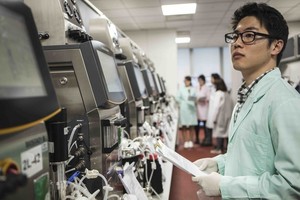In order to be approved by regulatory agencies, biosimilars are required to match all pharmacological properties of the originator protein drug to guarantee efficacy and alleviate safety concerns.
Glycosylation is a critical quality attribute of protein drugs since it can severely affect efficacy and safety. Unfortunately, glycosylation can be difficult to control since – unlike the drug’s amino acid sequence – it does not follow a template, but instead is the product of a complex reaction network which is influenced by a variety of genetic, metabolic and abiotic factors. Consequently, matching the glycosylation (the ‘glycoprofile’) of the originator drug is a challenging endeavour that relies considerably on trial-and-error experimentation, thus causing considerable expenditures in labour and material and driving up production costs. In particular, it is often unclear which biochemical pathways in the glycosylation network need to be targeted (and to what degree) in order to tweak the glycoprofile from the in-house production cell line towards the glycoprofile on the originator drug.
Computer simulations could be an invaluable tool to aid in these glycoengineering efforts since they run fast, and can be generated with minimal personnel and material expenses. Authors from the University of California and the Technical University of Denmark present such a simulation framework based on a probabilistic model of protein glycosylation that has been described previously (Spahn, et al. Met Eng. 2016).
To run the simulation, the user provides two glycoprofiles: the starting profile, i.e. the glycoprofile obtained from the in-house production cell line; and the target profile, i.e. the glycoprofile of the originator drug that needs to be matched. Using a genetic algorithm, the simulation then determines which biochemical pathways need to be targeted (and to what degree) to move the starting profile and match the target profile. These computational predictions can then serve as valuable guidelines for follow-up experiments, and potentially can help find the optimal glycoengineering strategy while taking only a fraction of time and labour requirements.
The simulation can also be applied to identify clones or cell lines that will provide the simplest glycoengineering effort. Specifically, simulations can be run for several different in-house production cell lines and the model can predict the optimal choice for glycoengineering efforts. In this case, based on the starting profiles of each of the candidates, the simulation can determine which can achieve the closest match to the target profile. Predictions like this can help find an optimal production host since experimentation does not have to be carried out in parallel for multiple clones.
In summary, the algorithm has the potential to make glycoengineering efforts more amenable to rational approaches, thus simplifying the production process, and helping to make biosimilars more affordable and sustainable.
Conflict of interest
The authors of the research paper [1] declared that there were no conflicts of interest.
Abstracted by Assistant Professor Nathan E Lewis, Department of Pediatrics, University of California San Diego, School of Medicine, La Jolla, CA, USA.
Editor’s comment
Readers interested to learn more about glycoengineering and biosimilars are invited to visit www.gabi-journal.net to view the following manuscript published in GaBI Journal:
Importance of manufacturing consistency of the glycosylated monoclonal antibody adalimumab (Humira®) and potential impact on the clinical use of biosimilars
GaBI Journal is indexed in Embase, Scopus, Thomson Reuters’ ESCI, and more.
Readers interested in contributing a research or perspective paper to GaBI Journal – an independent, peer reviewed academic journal – please send us your submission here.
Related article
Acceptable changes in quality for glycosylated biologics
Reference
1. Spahn PN, Hansen AH, Kol S, Voldborg BG, Lewis NE. Predictive glycoengineering of biosimilars using a Markov chain glycosylation model. Biotechnol J. 2017;12(2). doi:10.1002/biot.201600489. Epub 2016 Dec 28.
Permission granted to reproduce for personal and non-commercial use only. All other reproduction, copy or reprinting of all or part of any ‘Content’ found on this website is strictly prohibited without the prior consent of the publisher. Contact the publisher to obtain permission before redistributing.
Copyright – Unless otherwise stated all contents of this website are © 2017 Pro Pharma Communications International. All Rights Reserved.








 0
0











Post your comment